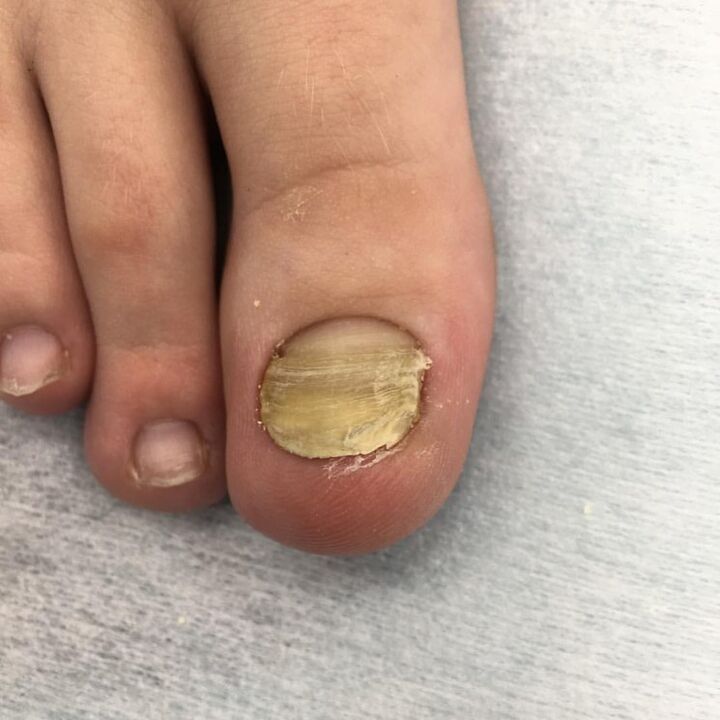Onychomycosis - Damage to nails with a fungal infection. The disease occurs in 5 to 10% of the population and, among other nail lesions, is about 30%.
The causes of onychomycosis
The infection of foot nail plates occurs mainly in public baths, saunas, swimming pools. Scales with pathogenic mushrooms, which fall into onicomycosis patients, fall on floors, benches, bars, paths, rugs and trash. Under high -humidity conditions, mushrooms may not only persist for a long time, but also multiply, especially in painted benches and wooden grids, making them an intense source of infection.

Frequently, onicomycosis is transmitted inside the family when wearing shoes, towels, towels, insufficient bath processing after washing, as well as due to rugs and grids in the bathroom. Damage to the nails of the hands usually occurs when combing the focus on the skin.
Onychomycosis is facilitated by nail trauma, especially multiple (in athletes), impaired blood supply in limbs, serious concomitant diseases (diabetes mellitus, states of immunodeficiency, blood disease).
Onychomycosis is often found in people who have long received antibacterial, corticosteroid and immunosuppressive therapy. The injury of nail plates occurs second: at first, mushrooms affect the interdigital folds or the sole and then nails.
Three types of onychomycosis are distinguished around the world:
- Normotorotic,
- hypertrophic
- Atrophic.
With a kind of smooth onychomycosis scar, only the color of the nails changes: in their departments, blemishes and extreme bands appear, whose color varies from white to guard. Gradually, the whole nail changes the color, but keeping normal shine and thickness.
With a hypertrophic type, the color changes, the nail loses its shine, becomes monotonous, thickened and deforming, partially destroyed, especially from the sides. Often patients experience pain when walking. A typical nail fungus is characterized by a brownish and brownish color of the affected part of the nail, its thinning and rejection of the box; The naked area is covered with loose layers.
We treat the fungus
Local antifungal agents are ineffective with damage to nail plates. Processing with antifungal ointments, creams, solutions and varnishes should be preceded by removing the affected area of the nail mechanically or using keratolytic pushes.
Mechanical removal consists of cutting or cutting with stings of affected fragments of the nail plate.
The use of keratolytic rebases in the treatment of onychomycosis allows you to soften the nail as a result that it removes easily and painlessly from the nail bed surface with a scalpel or an opaque scissors.
As a keratolytic agent, a medicine is used, which includes an ointment containing 1% antifungal agent and 40% urea. The ointment is applied to the surface of the nail and covered with the attached adhesive and dressing. After one day, the areas affected by onychomycosis are clean. The procedures are performed daily until the affected nails are completely removed. In the future, as the affected nail is removed, the places are used: antifungal varnishes.
- In the first month of treatment, a medicine is prescribed to 6-8 tablets a day (750-1000 mg), the second dose every day and then until the growth of healthy nail plates 2 times a week. It is taken at 3 doses with a teaspoon of vegetable oil. The duration of treatment for brushes of brushes is 4-6 months, with a foot ringworm-9-12 and up to 18 months.
- Treatment with the preparation against the fungus ensures a cure only in 40% of patients. A combination with nail removal increases the percentage of healing. However, a large number of side effects, as well as a high relapse percentage of the disease, limits its use.

For successful and safe treatment of onicomycosis, it is advisable to adhere to certain rules with systemic antifungal medications.
First of all, the diagnosis must be reliable. The drug should not be prescribed if there is no laboratory confirmation.
After diagnosis, it is necessary to carefully collect an allergic history. If, at the same time, medications or foods that cause allergic reactions or any other intolerance manifestations are detected, their intake should be excluded.
For the treatment period with systemic antimicots, it is advisable to limit the use of other medications except vital.
Prevention and Treatment
To avoid gastrointestinal disorders, it is recommended to exclude products that cause food flatulence during treatment: black bread, vegetables, milk, cabbage.
Little importance is the selection of comfortable shoes during treatment and after completion. Often, an improvement in the condition of the affected nail clearly correlates with the use of non -traumatic shoes, since pollination of tissues caused by shoes can cause exacerbation or distal to preach onomicosis. Before starting treatment, it is advisable to conduct a study of general and biochemical test indicators.
Control tests should be performed for the first time after 2 weeks and then 1 time per month. Control microscopy - 6 months after the end of treatment. The identification of mycelium of pathogenic fungi serves as an indication for a second course of treatment with preliminary surgical removal of affected nails.
Prognosis for the treatment of onychomycosis
Despite the high healing percentage for patients with onychomycosis when using therapeutic agents, therapy with these medications does not exclude the use of local antifungal medications. The combination with conservative and surgical removal of nail plates reduces time to take systemic anti -bactericides and increases the effectiveness of treatment.























